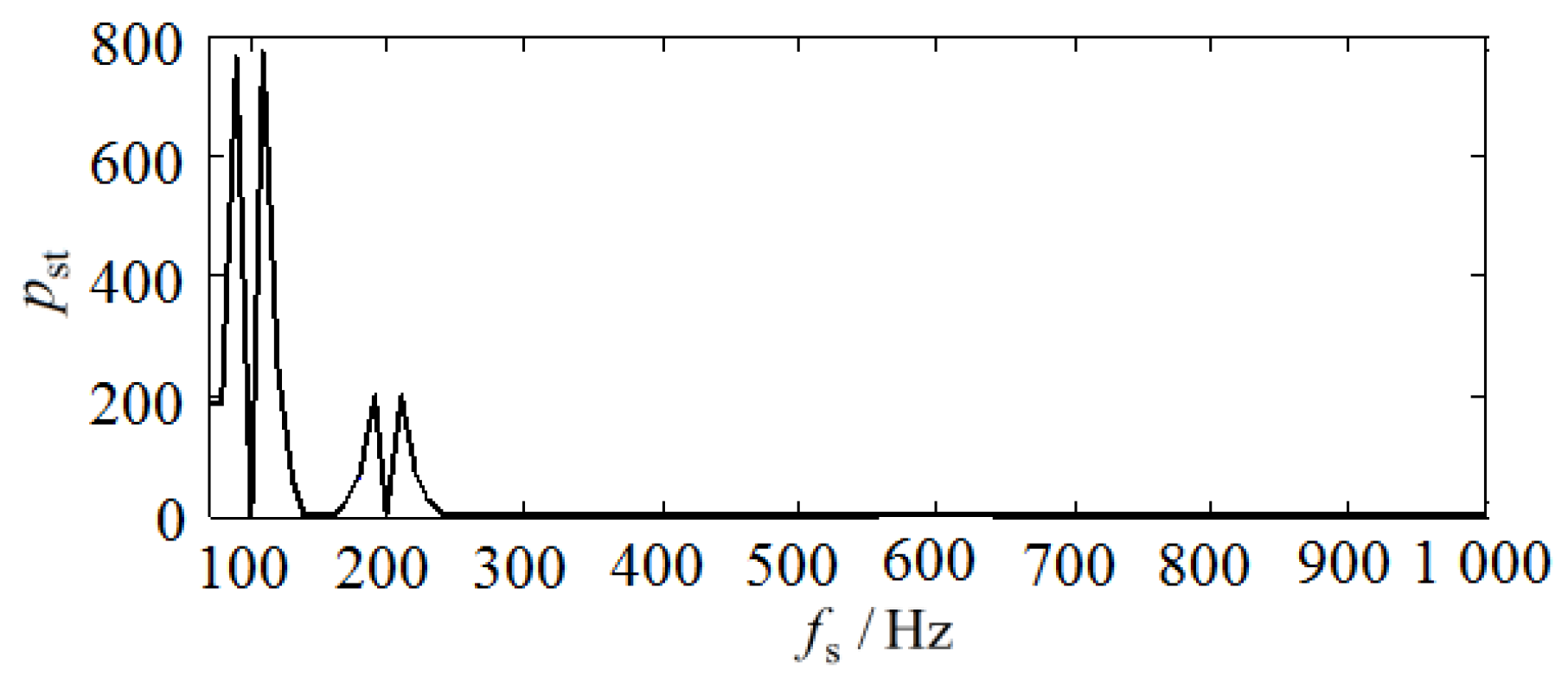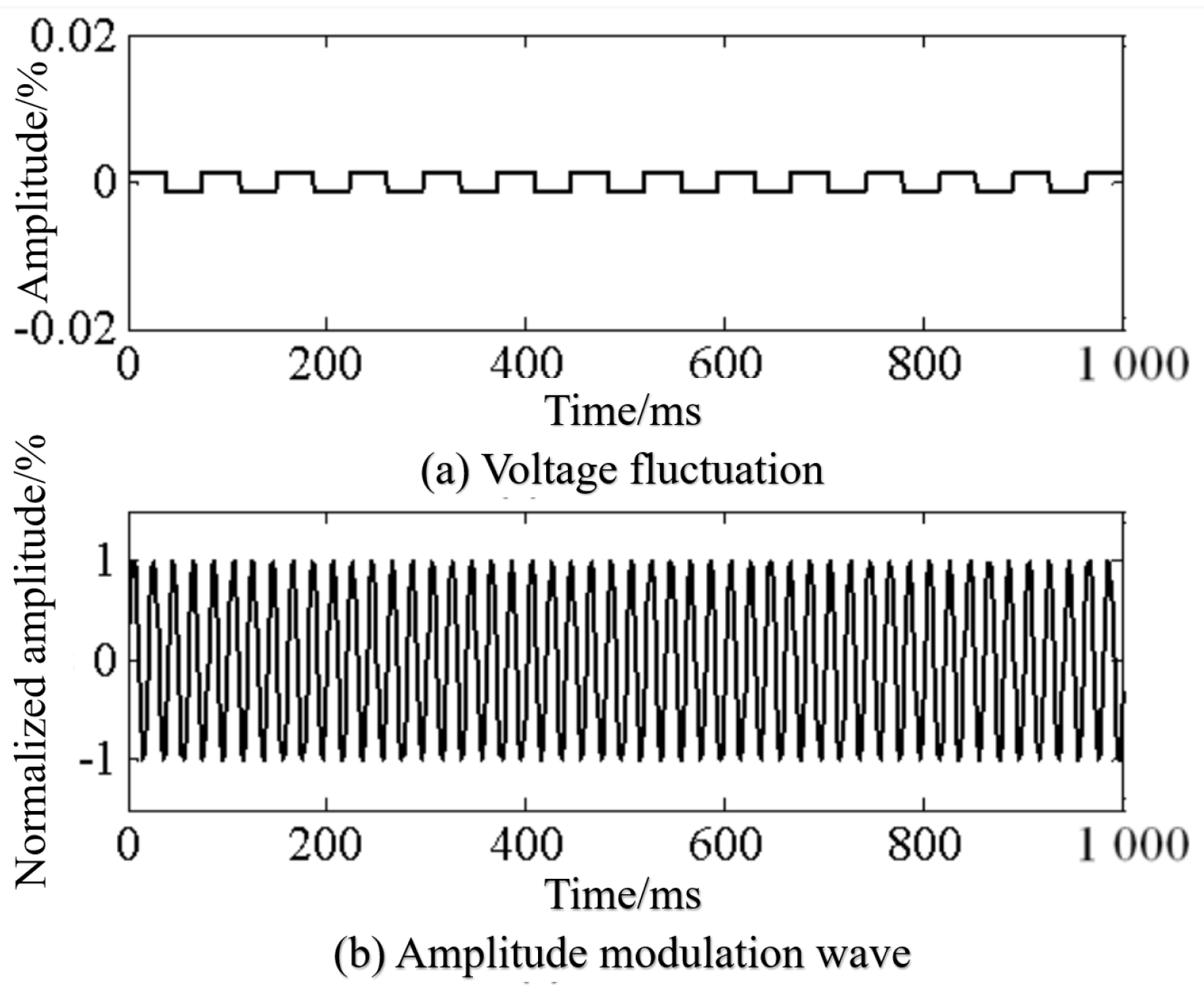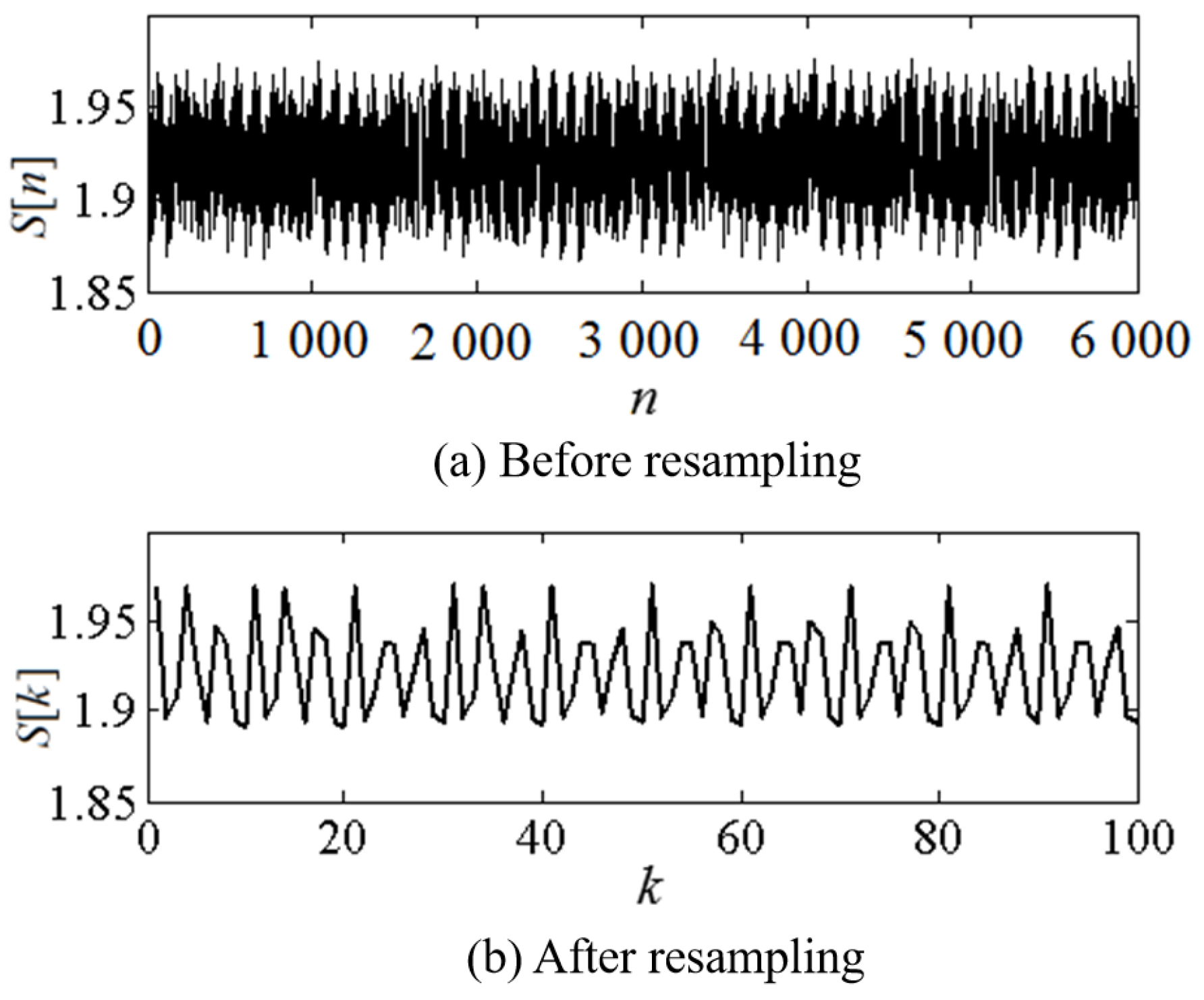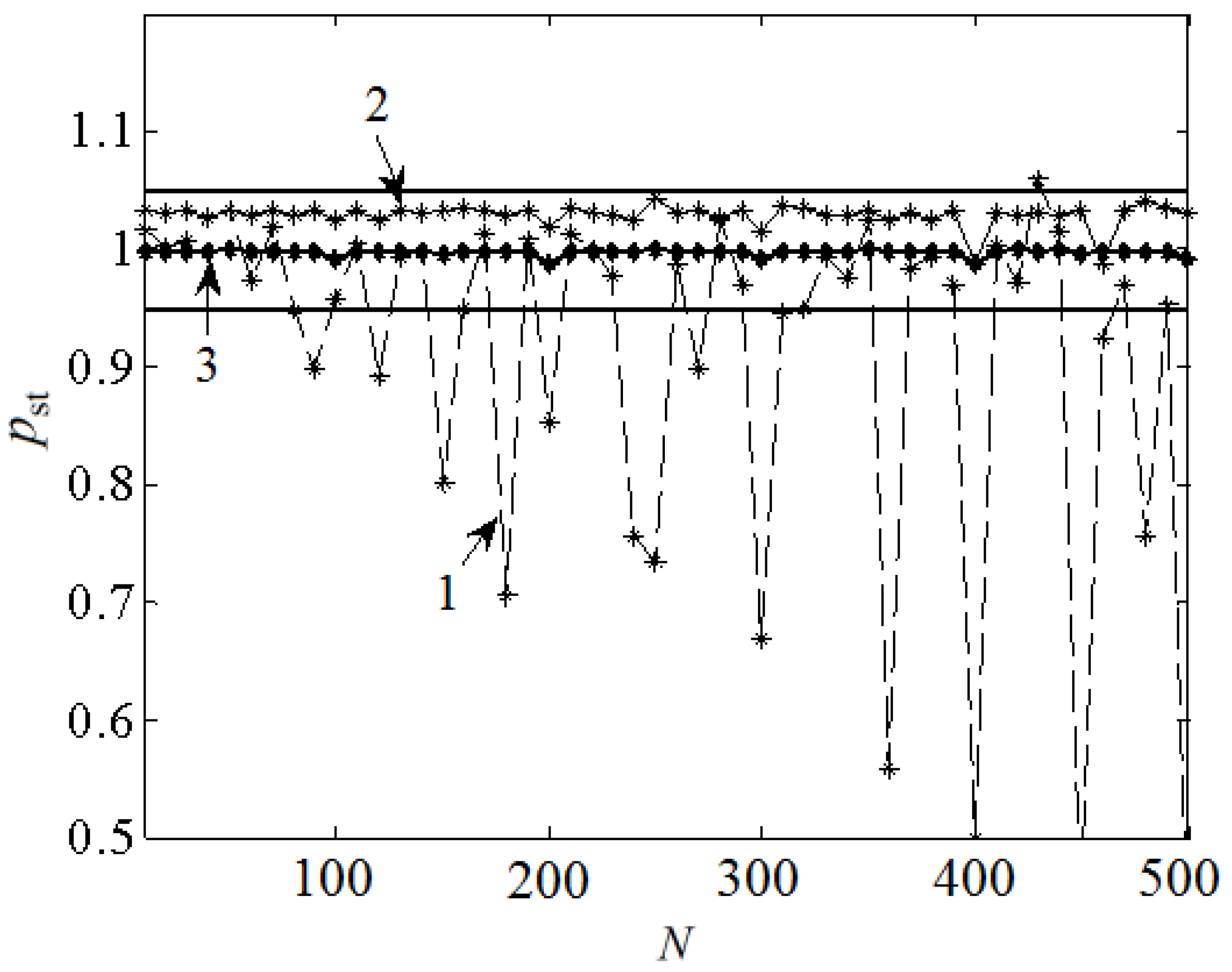Voltage Flicker Detection Based on Probability Resampling
Abstract
1. Introduction
2. Flicker Detection Principle
2.1. IEC Flicker Detection Design Specification
2.2. Principle of Probability Resampling
2.3. Procedure of Probability Resampling Flicker Detection
- Step 1:
- Sample the measured signal to obtain the discrete signal ;
- Step 2:
- Square detection of the discrete signal to obtain voltage fluctuation signals that humans perceive from the range of 0.05–35 Hz;
- Step 3:
- Simulate the subjective visual reflection of the voltage fluctuation signal by a digital filter to obtain instant flicker visual sensitivity ;
- Step 4:
- Probability resample and compress redundant data to obtain , and then sort and store ;
- Step 5:
- Determine whether the measurement time reaches 10 min; if not, return to step 2; otherwise, go to step 6;
- Step 6:
- Statistical calculation of short-term flicker value.
3. Methods
3.1. Selection of Sampling Frequency
3.2. Voltage Fluctuation Detection
3.3. Filter Digitization
3.4. Probability Resampling Frame Format
4. Method Validation
4.1. Simulation Verification and Discussion
4.2. Engineering Tests and Discussion
5. Conclusions
Author Contributions
Funding
Conflicts of Interest
References
- Wei, L.J.; Zhan, P.; Liu, Z.G.; Tao, Y.H.; Yue, D.L. Modeling and analysis of maximum power tracking of a 600 kW hydraulic energy storage wind turbine test rig. Processes 2019, 7, 706. [Google Scholar] [CrossRef]
- Al-Shetwi, A.Q.; Hannan, M.A.; Jern, K.P.; Alkahtani, A.A.; PG Abas, A.E. Power quality assessment of grid-connected PV system in compliance with the recent integration requirements. Electronics 2020, 9, 366. [Google Scholar] [CrossRef]
- Castello, P.; Muscas, C.; Pegoraro, P.A.; Sulis, S. PMU’s behavior with flicker-generating voltage fluctuations: An experimental analysis. Energies 2019, 12, 3355. [Google Scholar] [CrossRef]
- Von Meier, A.; Stewart, E.; McEachern, A.; Andersen, M.; Mehrmanesh, L. Precision micro-synchrophasors for distribution systems: A summary of applications. IEEE Trans. Smart Grid 2017, 8, 2926–2936. [Google Scholar] [CrossRef]
- Redondo, K.; Gutiérrez, J.J.; Azcarate, I.; Saiz, P.; Leturiondo, L.A.; Ruiz de Gauna, S. Experimental study of the summation of flicker caused by wind turbines. Energies 2019, 12, 2404. [Google Scholar] [CrossRef]
- Jumani, T.A.; Mustafa, M.W.; Rasid, M.M.; Anjum, W.; Ayub, S. Salp swarm optimization algorithm-based controller for dynamic response and power quality enhancement of an islanded microgrid. Processes 2019, 7, 840. [Google Scholar] [CrossRef]
- Nieto, A.; Vita, V.; Maris, T.I. Power quality improvement in power grids with the integration of energy storage systems. Int. J. Eng. Res. 2016, 7, 438–443. [Google Scholar]
- Santos, E.; Khosravy, M.; Lima, M.A.A.; Cerqueira, A.S.; Duque, C.A.; Yona, A. High accuracy power quality evaluation under a colored noisy condition by filter bank ESPRIT. Electronics 2019, 8, 1259. [Google Scholar] [CrossRef]
- Lodetti, S.; Azcarate, I.; Gutiérrez, J.J.; Leturiondo, L.A.; Redondo, K.; Sáiz, P.; Melero, J.J.; Bruna, J. Flicker of modern lighting technologies due to rapid voltage changes. Energies 2019, 12, 865. [Google Scholar] [CrossRef]
- IEC. International Electrotechnical Vocabulary—Part 614: Generation, Transmission and Distribution of Electricity— Operation; IEC 60050-614; International Electrotechnical Commission (IEC): Geneva, Switzerland, 2016. [Google Scholar]
- IEC. Electromagnetic Compatibility (EMC)—Part 4-15: Testing and Measurement Techniques-Flickermeter-Functional and Design Specifications; IEC 61000-4-15 Ed.2; International Electrotechnical Commission (IEC): Geneva, Switzerland, 2010. [Google Scholar]
- IEC. Electromagnetic Compatibility (EMC)—Part 3-7: Limits—Assessment of Emission Limits for the Connection of Fluctuating Installations to MV, HV and EHV Power Systems; IEC 61000-3-7; International Electrotechnical Commission (IEC): Geneva, Switzerland, 2008. [Google Scholar]
- IEC. Electromagnetic Compatibility (EMC)—Part 4-30: Testing and Measurement Techniques—Power Quality Measurement Methods; IEC 61000-4-30 Ed.3; International Electrotechnical Commission (IEC): Geneva, Switzerland, 2015. [Google Scholar]
- Tse, N.; Chan, J.; Lau, W.H.; Lai, H. Hybrid wavelet and Hilbert transform with frequency-shifting decomposition for ower quality analysis. IEEE Trans. Instrum. Meas. 2012, 12, 3225–3233. [Google Scholar] [CrossRef]
- Gao, Y.; Li, F.; Chen, J.; Teng, Z.; Cao, Y. Voltage flicker measurement method using improved teagerkaiser energy operator based on Nuttall window spectral correction. Chin. J. Sci. Instrum. 2014, 4, 67–75. [Google Scholar]
- Wu, C.J.; Chen, Y.J. A novel algorithm for precise voltage flicker calculation by using instantaneous voltage vector. IEEE Trans. Power Deliv. 2006, 3, 1541–1548. [Google Scholar] [CrossRef]
- Li, H.; Kang, W.; Yan, X.; Zhang, L. Voltage flicker measurement based on Chirp-Z transform. Trans. China Electrotech. Soc. 2009, 3, 209–215. [Google Scholar]
- Li, L.; Gao, Y.; Zhang, Y.; Wu, C.; Cao, Y. Voltage flicker envelope tracking based on improved k-value energy operator and improved Chirp-Z transform. Trans. China Electrotech. Soc. 2018, 11, 2636–2646. [Google Scholar]
- Srinivasan, S.; Krishnamoorthy, M.; Pongiannan, R.; Jeyasudha, S. Real time assessment of power quality issues in 11 kV/440 V distribution feeder using distribution static synchronous compensator. T I Meas. Control. 2020. [Google Scholar] [CrossRef]
- Moallem, P.; Zargari, A.; Kiyoumarsi, A. Improving IEC flickermeter for implementation by an ARM microcontroller-based digital system. T I Meas. Control. 2013, 3, 342–352. [Google Scholar] [CrossRef]
- Cifredo-Chacón, M.-Á.; Perez-Peña, F.; Quirós-Olozábal, Á.; González-de-la-Rosa, J.-J. Implementation of processing functions for autonomous power quality measurement equipment: A performance evaluation of CPU and FPGA-based embedded system. Energies 2019, 12, 914. [Google Scholar] [CrossRef]
- Zhu, J.; Zhu, M.; He, C.; Liao, G. Design of power quality on-line monitoring system based on dual CPU. Autom. Instrum. 2014, 11, 54–56. [Google Scholar]
- International Electrotechnical Commission. Electromagnetic Compatibility (EMC)—Part 4-15: Testing and Measurement Techniques—Flickermeter—Functional and Design Specifications; IEC Int. Std. 61000-4-15; International Electrotechnical Commission: Geneva, Switzerland, 2011. [Google Scholar]
- Wiczynski, G. Estimation of Pst indicator values on the basis of voltage fluctuation indices. IEEE Trans. Instrum. Meas. 2017, 66, 2046–2055. [Google Scholar] [CrossRef]
- Gao, H.T.; Zhu, E.L.; Huang, S.H. A method of digitized implement for IEC flicker detection standard. Proceedings of IEEE 8th Annual International Conference on CYBER Technology in Automation, Control, and Intelligent Systems; IEEE: Tianjin, China, 2018; pp. 879–882. [Google Scholar]









| Voltage Fluctuation Range (%) | Square Wave Fluctuation Frequency (Hz) | Unused Probability Resampling () | Probability Resampling () | Target Value |
|---|---|---|---|---|
| 2.21 | 0.016667 | 1.0156 | 0.9752 | 0.95∼1.05 |
| 0.905 | 0.325 | 1.0322 | 1.0284 | 0.95∼1.05 |
| 0.402 | 13.5 | 0.9983 | 0.9991 | 0.95∼1.05 |
| 1.5 × 0.905 | 0.325 | 1.5481 | 1.5425 | 1.425∼1.575 |
| 3.3 × 2.21 | 0.016667 | 3.3388 | 3.2063 | 3.135∼3.465 |
| 1 | 1/20 | 1/30 | 1/40 | 1/50 | 1/60 | |
|---|---|---|---|---|---|---|
| Data number (n) | 360,000 | 18,000 | 12,000 | 9000 | 7200 | 6000 |
| Storage capacity (Byte) | 2.75 M | 140.6 K | 93.8 K | 70.3 K | 6.3 K | 6.9 K |
| Time complexity () |
| Voltage Fluctuation Range (%) | Square Wave Fluctuation Frequency (/min) | Measurements | Target Value | ||
|---|---|---|---|---|---|
| Phase A | Phase B | Phase C | |||
| 2.724 | 1 | 0.98 | 0.97 | 1.01 | 0.95∼1.05 |
| 2.211 | 2 | 1.01 | 1.02 | 1.03 | 0.95∼1.05 |
| 1.459 | 7 | 1.01 | 0.97 | 0.98 | 0.95∼1.05 |
| 0.906 | 39 | 1.02 | 0.97 | 0.96 | 0.95∼1.05 |
| 0.725 | 110 | 1.01 | 0.98 | 1.04 | 0.95∼1.05 |
| 0.402 | 1620 | 1.02 | 0.97 | 0.99 | 0.95∼1.05 |
| 2.400 | 4000 | 0.97 | 0.98 | 1.02 | 0.95∼1.05 |
© 2020 by the authors. Licensee MDPI, Basel, Switzerland. This article is an open access article distributed under the terms and conditions of the Creative Commons Attribution (CC BY) license (http://creativecommons.org/licenses/by/4.0/).
Share and Cite
Gao, H.; Xu, P.; Tao, J.; Huang, S.; Wang, R.; Zhou, Q. Voltage Flicker Detection Based on Probability Resampling. Energies 2020, 13, 3350. https://doi.org/10.3390/en13133350
Gao H, Xu P, Tao J, Huang S, Wang R, Zhou Q. Voltage Flicker Detection Based on Probability Resampling. Energies. 2020; 13(13):3350. https://doi.org/10.3390/en13133350
Chicago/Turabian StyleGao, Haitao, Peng Xu, Jin Tao, Shihui Huang, Rugang Wang, and Quan Zhou. 2020. "Voltage Flicker Detection Based on Probability Resampling" Energies 13, no. 13: 3350. https://doi.org/10.3390/en13133350
APA StyleGao, H., Xu, P., Tao, J., Huang, S., Wang, R., & Zhou, Q. (2020). Voltage Flicker Detection Based on Probability Resampling. Energies, 13(13), 3350. https://doi.org/10.3390/en13133350







